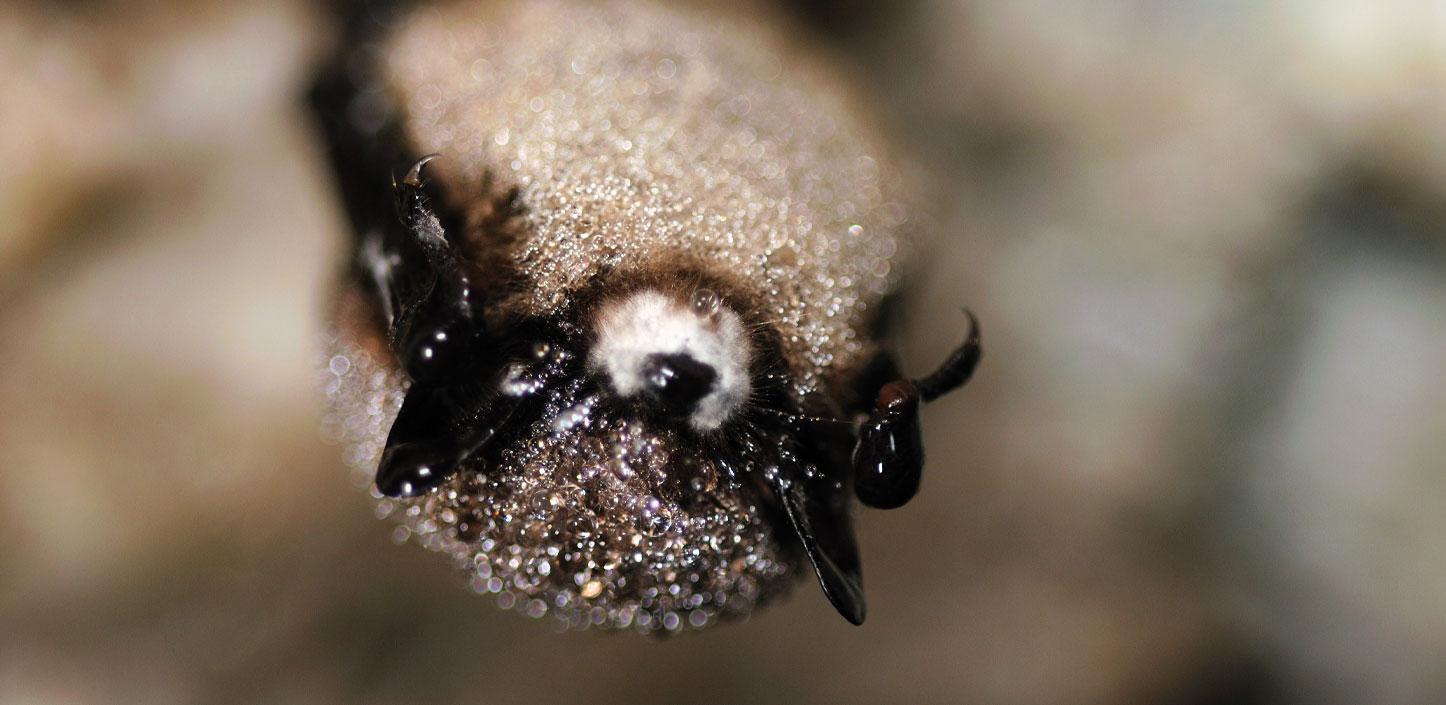
NFWF Announces More Than $546,000 in Grants to Help Bats
Three grants awarded to test strategies to stop white-nose syndrome from devastating bat populations
WASHINGTON, D.C. (March 30, 2020) –The National Fish and Wildlife Foundation (NFWF) today awarded more than $546,000 in grants to three projects to combat white-nose syndrome (WNS), a disease that is devastating bat populations in North America. The grants will generate more than $351,000 in matching contribution, for a total conservation impact of more than $897,000.
Two projects supported by the grants announced today will continue to test environmental treatments for WNS, using volatile organic compounds and non-toxic polyethylene glycol to reduce fungal loads in Georgia, Ohio and Pennsylvania. The third project will explore enhancing food sources for bats immediately pre- and post-hibernation in Michigan and Manitoba, Canada, with the expectation that increased fat reserves will help bats survive WNS.
Millions of bats have died over the past decade from WNS, which is caused by a cold-loving fungus that attacks hibernating bats. More than half of the bat species in the United States and Canada hibernate to survive the winter, making them potentially susceptible to the disease. Since signs of WNS were first observed in upstate New York in 2006, the disease has spread rapidly, moving steadily westward across the United States and into Canada. WNS has now been confirmed in 34 states and seven Canadian provinces, with new detections each year.
“The Bats for the Future Fund supports the development of management strategies that show potential to improve bat survival and help affected populations recover from white-nose syndrome,” said Dr. Jeremy Coleman, national white-nose syndrome coordinator for the U.S. Fish and Wildlife Service. “These three new grants continue to advance this urgent and impactful work.”
Bats are an important part of healthy natural environments, and they consume a considerable amount of insects, including many agricultural pests. The grants announced today were awarded through NFWF’s Bats for the Future Fund, which supports projects that aim to combat the effects of white-nose syndrome and perpetuate viable populations of bats in North America. Major funding for the Bats for the Future Fund is from the U.S. Fish and Wildlife Service, as well as Southern Company and the Avangrid Foundation.
This year’s Bats for the Future Fund recipients include:
- Temple University ($178,724) will treat and monitor hibernation sites used by little brown bats and other species to test the effectiveness of polyethylene glycol 8000 to suppress the fungus that causes white-nose syndrome. The project will conduct field trials at three control and three treatment hibernacula in Ohio and Pennsylvania, evaluate the effects on non-target flora and fauna, and strive to reduce the fungal infection rate by 50 percent.
- Bat Conservation International ($249,996) will improve survival of bats with WNS by enhancing their foraging efficiency near hibernacula in the fall, when bats accumulate critical fat reserves, and in spring, when bats are recovering from WNS. The project will use light and chemical attractants at seven sites in Michigan and Manitoba, Canada to concentrate insects near hibernacula in fall and spring to determine whether more insect prey improves survivability, with the goal of reducing the mortality rate from 71 percent to 30 percent.
- Kennesaw State University ($117,422) will implement an integrated disease management system to increase survivorship of tri-colored bat populations affected by WNS at Black Diamond Tunnel in Georgia. The project will fumigate Black Diamond Tunnel with volatile organic compounds to reduce the amount of the fungus that causes WNS and compare fungal loads and bat mortality with four other significant sites that are not receiving treatment, with the goal of reducing the fungal load to zero and reducing the mortality rate by 50 percent.
To learn more about the Bats for the Future Fund, visit www.nfwf.org/programs/bats-future-fund. To learn more about WNS, visit www.whitenosesyndrome.org.
About the National Fish and Wildlife Foundation
Chartered by Congress in 1984, the National Fish and Wildlife Foundation (NFWF) protects and restores the nation’s fish, wildlife, plants and habitats. Working with federal, corporate and individual partners, NFWF has funded more than 5,000 organizations and generated a total conservation impact of $6.1 billion. Learn more at www.nfwf.org.
About the U.S. Fish and Wildlife Service
The mission of the U.S. Fish and Wildlife Service is working with others to conserve, protect, and enhance fish, wildlife, plants, and their habitats for the continuing benefit of the American people. We are both a leader and trusted partner in fish and wildlife conservation, known for our scientific excellence, stewardship of lands and natural resources, dedicated professionals, and commitment to public service. For more information on our work and the people who make it happen, visit www.fws.gov.
# # #